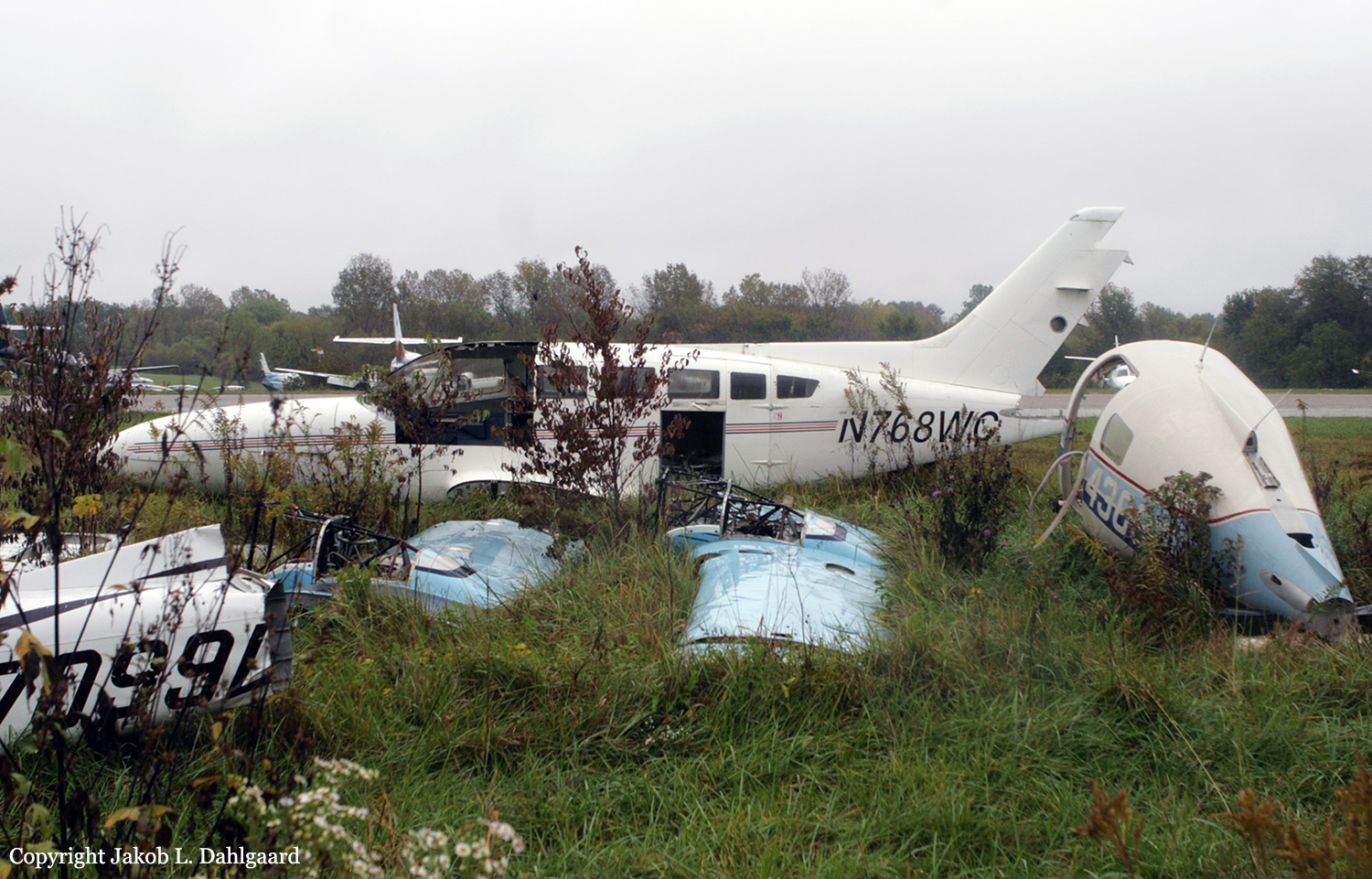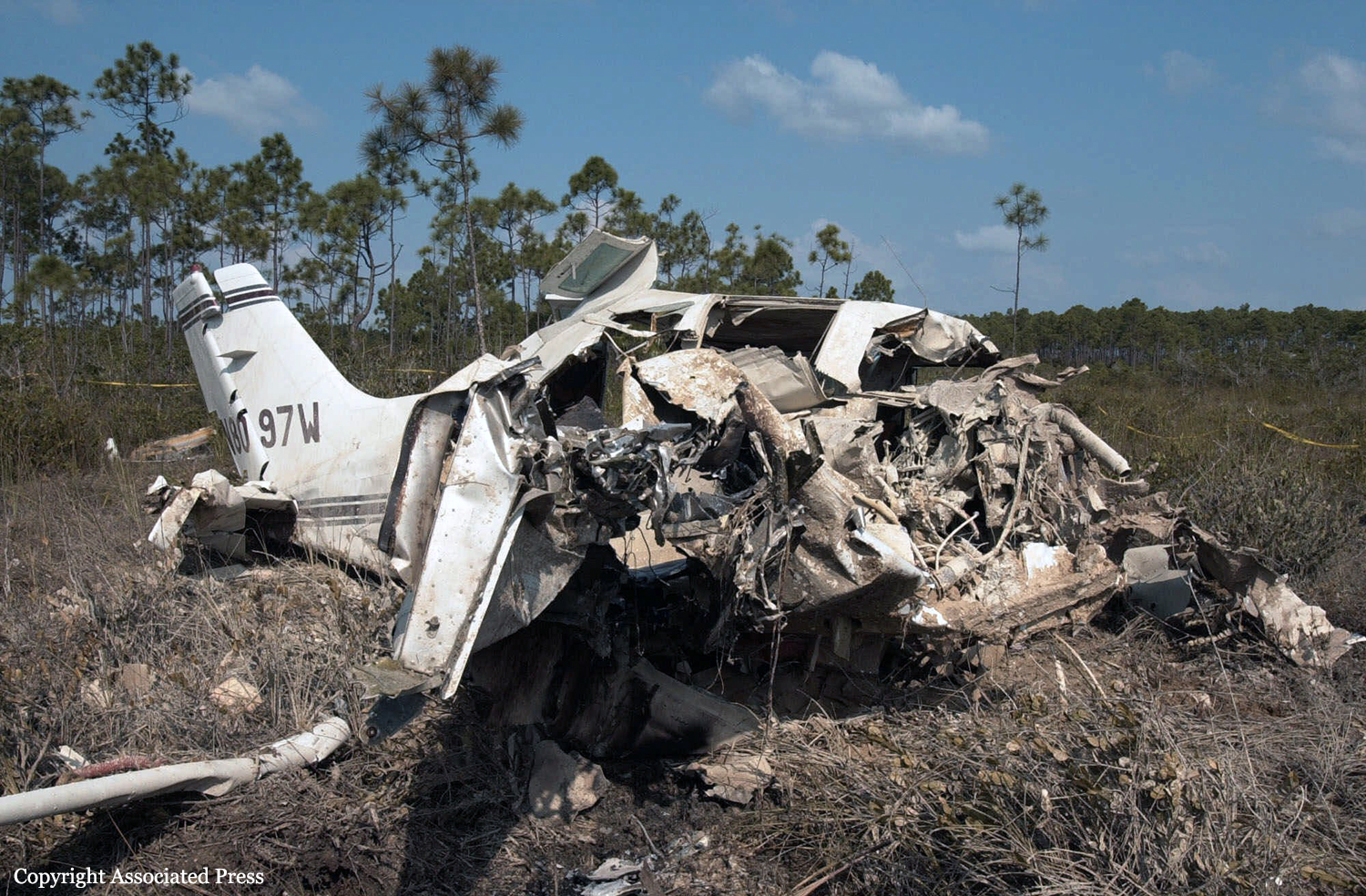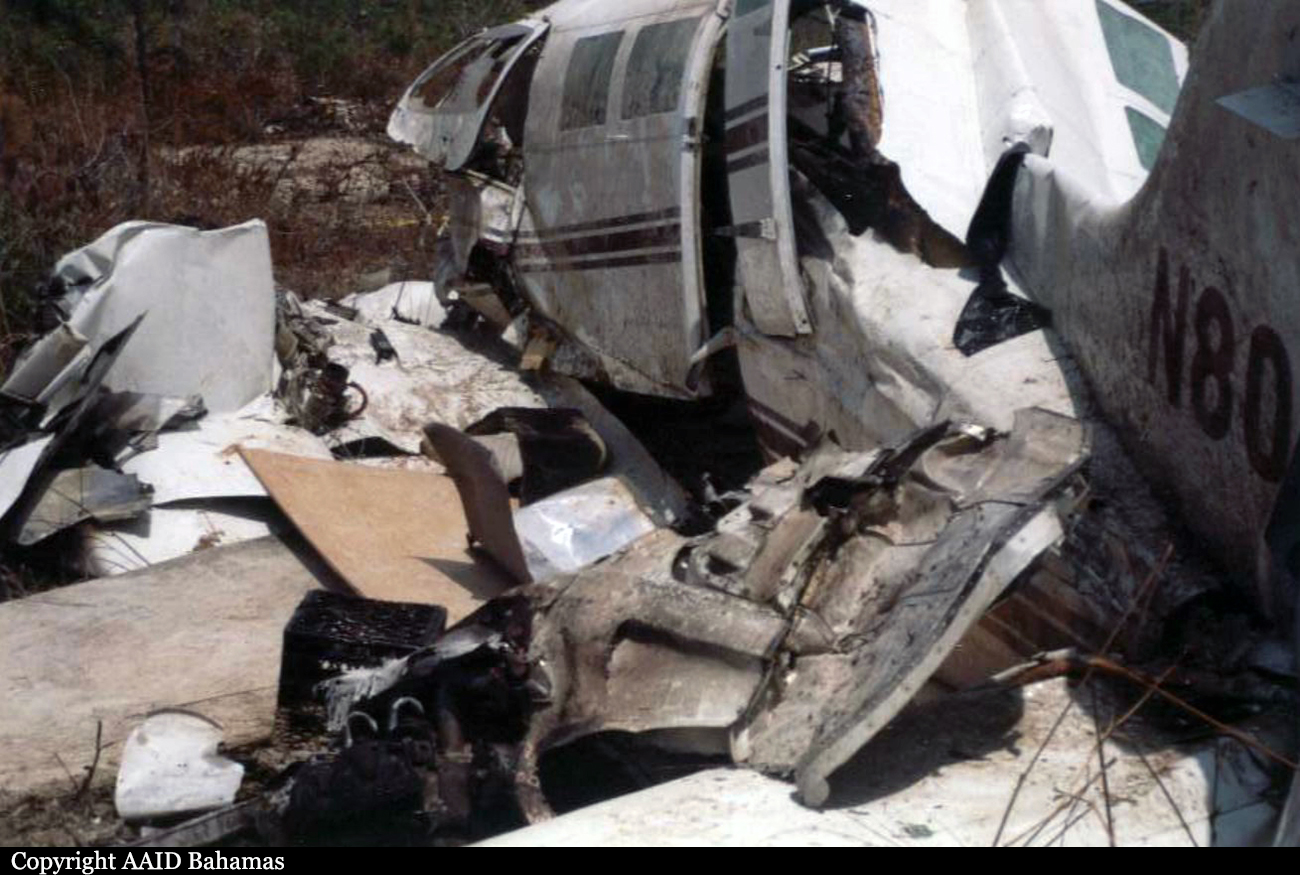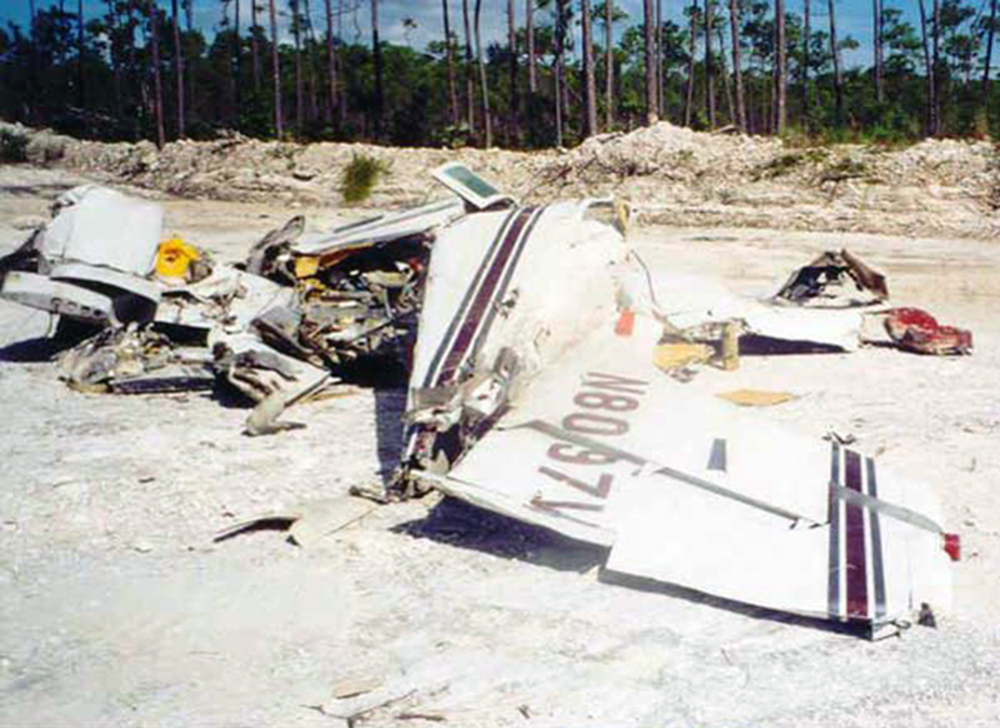Country
Crash of a Cessna 402B in Nassau
Date & Time:
Apr 3, 2002 at 1210 LT
Registration:
N768WC
Survivors:
Yes
Schedule:
Nassau - Bimini
MSN:
402B-1066
YOM:
1976
Crew on board:
1
Crew fatalities:
Pax on board:
1
Pax fatalities:
Other fatalities:
Total fatalities:
0
Circumstances:
On April 3, 2002, about 1210 eastern standard time, a Cessna 402B, N768WC, registered to and operated by Southstream Aviation, Inc., was ditched in Coral Harbor Lake, southwest of the Nassau International Airport, Nassau, Bahamas. Visual meteorological conditions prevailed at the time and a VFR flight plan was filed for the 14 CFR Part 91 personal flight to Bimini, Bahamas. The airplane was substantially damaged and the commercial-rated pilot and a passenger were not injured. The flight originated about 6 minutes earlier from the Nassau International Airport. According to the passenger who is a U.S. certificated pilot, the airplane was fueled before takeoff. He checked the fuel tanks for contaminants after fueling; none were found. The flight departed from runway 14, then when turning on course to Bimini, the left engine sputtered. The pilot reduced then increased power from the left engine which then quit. He noted at that time the manifold and fuel pressure indications were decreasing. The pilot then turned back towards the Nassau airport to return when the right engine quit. Unable to return to the airport, the pilot ditched the airplane in the lake; the airplane remained upright in the approximately 1-4 feet deep water. Both occupants exited the airplane unaided. The accident site was located approximately 2.6 nautical miles southwest of the Nassau International Airport.

Crash of a Cessna 402B in Bronson: 1 killed
Date & Time:
Jan 23, 2002 at 0735 LT
Registration:
N371JD
Survivors:
No
Schedule:
Sturgis - Ann Arbor
MSN:
402B-1322
YOM:
1978
Crew on board:
1
Crew fatalities:
Pax on board:
0
Pax fatalities:
Other fatalities:
Total fatalities:
1
Aircraft flight hours:
7339
Circumstances:
The airplane was destroyed when it impacted the ground while maneuvering at a low altitude following a loss of control in instrument meteorological conditions. The airplane was on a flight in instrument meteorological conditions when radar and voice contact were lost. Prior to the loss of communication, controllers advised the pilot to check altitude. At this point, the radar data shows that the airplane was about 400 feet below the assigned altitude. Subsequently, the pilot said, "roger sir my auto pilot i just cut off uh correcting immediately." This was the last received transmission from the pilot. The radar data shows that the airplane then began a descending right turn at an average rate of descent of 1,276 feet per minute. This descent was followed by a climbing left turn with an average rate of climb of 5,423 feet per minute. The radar data shows that the radius of the left turn continued to decrease until radar contact was lost about 500 feet above the last assigned altitude. A witness who saw the airplane just prior to impact described the airplane maneuvering beneath the clouds prior to pulling up sharply and then pitching down and impacting the ground. There was a utility wire and associated poles running across the airplane's flight path in the field where the wreckage was located. The airplane exploded and burned upon impact. No anomalies were found with the airplane or associated systems. The autopilot section of the Pilot's Operating Handbook states, "Sustained elevator overpower will result in the autopilot trimming against the overpower force." The result is that if up elevator pressure is applied with the autopilot engaged, the autopilot will trim the airplane nose down.
Probable cause:
The maneuver to avoid the utility wire while maneuvering resulting in an inadvertent stall and subsequent impact with the ground. Factors were the pilot's inadvertent activation of the elevator trim, resulting in a loss of control during flight in instrument meteorological conditions, as a result of pilot's lack of knowledge concerning the operation of the autopilot system. Another factor was the utility wire.
Final Report:
Crash of a Cessna 402B in Marsh Harbour: 9 killed
Date & Time:
Aug 25, 2001 at 1845 LT
Registration:
N8097W
Survivors:
No
Schedule:
Marsh Harbour – Miami-Opa Locka
MSN:
402B-1014
YOM:
1975
Crew on board:
1
Crew fatalities:
Pax on board:
8
Pax fatalities:
Other fatalities:
Total fatalities:
9
Circumstances:
The fatal aircraft, Registration N8097W was operated by Blackhawk International Airways and the listed owner was Skystream Inc; whose corporate address was the same as Mr. Gilbert Chacón’s Pembroke Pines, Florida home address. Blackhawk International Airways was owned by Gilbert Chacón and his son Erik, who founded the company in 1991. Blackhawk International Airways was authorized by the FAA as a part 135 Single Pilot Operation. Mr. Gilbert Chacon was the only pilot authorized by the FAA for Blackhawk International Airways. Once Morales acted as pilot- in-command of the Cessna 402B aircraft, this made Blackhawk International Airways a multi pilot operation. This was a clear violation of the FAA regulations. Mr. Morales was not signed off by the FAA to fly for Blackhawk International Airways, nor was Blackhawk International Airways signed off as a multi pilot operation. There were no FAA reports of any enforcement actions or service difficulty reports against the fatal aircraft. However, the FAA did report four administrative actions against Blackhawk International Airways, three for technical violations and the most recent for maintenance failures. The agency (FAA) issued a letter of correction on April 28, 2000, citing Blackhawk's failure to comply with manufacturer’s recommended maintenance programs and FAA programs for its aircraft's engines or other parts. Blackhawk failed to have a person in charge of maintenance with an appropriate certificate and used unsanctioned techniques and equipment for repairs. The Manager of the Palm Beach County Park Airport at Lantana, Florida stated that a last minute change resulted in the accident aircraft being dispatched to Marsh Harbour, Abaco, Bahamas. The Cessna 404 aircraft which was originally scheduled to conduct this flight, was fuelled, but subsequently changed to a Cessna 402B aircraft by the owner Mr. Gilbert Chacon. This charter flight from Lantana, Florida to the island of Marsh Harbour, Abaco, in the Bahamas, was operated under Visual Flight Rules (VFR).The accident occurred on August 25, 2001 shortly after the aircraft departed Marsh Harbour International Airport for the return trip to Opa Locka, Florida (USA). The flight number was not known. At the time of the accident, Blackhawk International Airways was not authorized by the Bahamas Aviation Authority to conduct commercial operations in the Bahamas. A determination could not be made as to whether or not the pilot filed a flight plan. No records existed to verify whether radio communications were established with Air Traffic Control (ATC) during the flight from Lantana, Florida to Marsh Harbour, Abaco, Bahamas. The flight was a 165 mile journey that was estimated to take one (1) hour to complete. The aircraft was not required to have a cockpit voice recorder. Witnesses reported the pilot and members of the group being transported, argued about the number of passengers and the amount of bags to be loaded on the aircraft. Witnesses also reported seeing eight (8) passengers board the aircraft. Two of the largest passengers (believed to be weighing approximately 300 pounds each,) were observed being seated in the rear of the aircraft. One witness reported that the pilot personally loaded the aircraft. Witnesses also reported that the pilot experienced problems starting the engines. Eye witness statements placed the time of departure of the flight for Opa Locka, Florida at approximately 1845 EDT. The aircraft became airborne from the 5,000 x 50 feet runway (Runway 27) between 2,500 to 2,800 feet. It climbed in a steep nose high attitude to approximately 40 feet above the runway, banked left, pitched nose down and impacted marshy terrain in a left wing, nose low attitude. The aircraft was destroyed and all nine occupants were killed, among them the US singer Aaliyah Dana Haughton.
Probable cause:
Findings and Probable Cause:
- Aircraft overweight. Pilot did not determine if the aircraft was within operating limitations. The aircraft’s weight was estimated to be 941 lbs over the maximum allowable takeoff weight. The weight of the un-recovered bag was not added to the weight and balance calculations. The center of gravity was estimated to be 4.4 inches aft of the maximum aft allowable center of gravity envelope).
- Pilot Unqualified. Pilot was not qualified under Part 135 for the aircraft in which he was flying.
- Documents Falsification. Pilot falsified logbook to reflect more flight time than he actually had accumulated. Review of pilot logbook revealed in several instances, pilot added as much as 1,000 hours to his total flight and multi engine times. Hundreds of day and night landings were falsified to meet qualification requirements. Pilot falsified aircraft information (types and registration numbers) reporting them to be Cessna C402 aircraft, when FAA database clearly lists the aircraft in question as aircraft other than Cessna C402. Pilot may not have completed a weight and balance report. (No evidence existed that showed he had completed a load manifest or weight and balance and performance calculations). Pilot failed to comply with prescribed Weight and Balance and Performance limitations in Pilot’s Operating Handbook. (The aircraft’s weight was estimated to be 941 lbs over the maximum allowable takeoff weight. The weight of the un-recovered bag was not added to the weight and balance calculations. The center of gravity was estimated to be 4.4 inches aft of the maximum aft allowable center of gravity envelope)). Pilot may not have followed “before takeoff” checklist in Pilot’s Operating Handbook.
- Fuel Selectors: “Left Engine – Left Main Tank, Right Engine – Right Main Tank”. Field investigation immediately following the accident revealed both fuel tank selectors were found selected to the right main tank. The left fuel valve was found in the left position, though the cable was separated from the valve. Impact damage may have changed the pre-impact settings, thereby rendering the observed positions as unreliable.
- Aircraft Flight Controls (secondary control surfaces – trim tabs) were found to be out of normal range required for takeoff. The aileron trim tab was found selected all the way to the right. The rudder trim tab was found selected to the left and the elevator trim tab was found in the full nose down position. Impact damage may have changed the pre-impact settings, thereby rendering the observed positions as unreliable.
- According to Pilot’s Operating Handbook (POH) normal takeoff is 0˚ flaps. (The flap selector handle was selected to 15˚with the indicator at approximately the 15˚position. The wing flap push rods were bent, indicating partial extension at impact).
- Blackhawk International Airways was not authorized to assign this pilot as a pilot in command because they did not have the authority to use a second pilot. Blackhawk International Airways was authorized as a single pilot operation with Mr. Gilbert Chacon as the only authorized pilot.
- Blackhawk International Airways reportedly hired Mr Morales two days prior to the fatal accident, although they did not have the authority to use a second pilot. Further, they did not exercise due diligence in ensuring pilot’s qualification prior to assigning duty as pilot in command.
- There were no FAA reports of any enforcement actions or service difficulty reports against the fatal aircraft. However, the FAA did report four administrative actions against Blackhawk, three for technical violations and the most recent for maintenance failures. The agency issued a correction letter April 28, 2000, citing Blackhawk's failure to comply with manufacturer recommended maintenance programs and FAA programs for its aircraft's engines or other parts, Blackhawk failed to have a person in charge of maintenance with an appropriate certificate and used unsanctioned techniques and equipment for repairs.
- Results of disassembly report confirms that no discrepancies existed that would have precluded normal operation of both left and right engines prior to impact.
- Forensic Report showed traces of benzoylegonine (a metabolite of cocaine) in the urine and traces of ethanol in the stomach contents of the pilot.
- On July 7, 2001, Morales was arrested by the Broward Sheriff's Office in an area of Pompano Beach known for drug sales. A deputy who pulled over Morales' 1993 Volkswagen Fox for running a stop sign said he found pieces of crack cocaine and other paraphernalia in the car. According to the deputy, Morales said he was in the area to buy powder cocaine for a friend.
- In November 2000, Morales was arrested by Fort Lauderdale police after he tried to "return'' $345 worth of stolen aviation parts to a local distributor. Instead of giving Morales cash, store employees called police, who were investigating a string of airplane burglaries. Mr. Morales was charged with dealing in stolen property after detectives found that a receipt in his bag belonged to the burglary victim who actually bought the parts. An additional charge of grand theft was tacked on when detectives recovered other stolen items.
- Aircraft overweight. Pilot did not determine if the aircraft was within operating limitations. The aircraft’s weight was estimated to be 941 lbs over the maximum allowable takeoff weight. The weight of the un-recovered bag was not added to the weight and balance calculations. The center of gravity was estimated to be 4.4 inches aft of the maximum aft allowable center of gravity envelope).
- Pilot Unqualified. Pilot was not qualified under Part 135 for the aircraft in which he was flying.
- Documents Falsification. Pilot falsified logbook to reflect more flight time than he actually had accumulated. Review of pilot logbook revealed in several instances, pilot added as much as 1,000 hours to his total flight and multi engine times. Hundreds of day and night landings were falsified to meet qualification requirements. Pilot falsified aircraft information (types and registration numbers) reporting them to be Cessna C402 aircraft, when FAA database clearly lists the aircraft in question as aircraft other than Cessna C402. Pilot may not have completed a weight and balance report. (No evidence existed that showed he had completed a load manifest or weight and balance and performance calculations). Pilot failed to comply with prescribed Weight and Balance and Performance limitations in Pilot’s Operating Handbook. (The aircraft’s weight was estimated to be 941 lbs over the maximum allowable takeoff weight. The weight of the un-recovered bag was not added to the weight and balance calculations. The center of gravity was estimated to be 4.4 inches aft of the maximum aft allowable center of gravity envelope)). Pilot may not have followed “before takeoff” checklist in Pilot’s Operating Handbook.
- Fuel Selectors: “Left Engine – Left Main Tank, Right Engine – Right Main Tank”. Field investigation immediately following the accident revealed both fuel tank selectors were found selected to the right main tank. The left fuel valve was found in the left position, though the cable was separated from the valve. Impact damage may have changed the pre-impact settings, thereby rendering the observed positions as unreliable.
- Aircraft Flight Controls (secondary control surfaces – trim tabs) were found to be out of normal range required for takeoff. The aileron trim tab was found selected all the way to the right. The rudder trim tab was found selected to the left and the elevator trim tab was found in the full nose down position. Impact damage may have changed the pre-impact settings, thereby rendering the observed positions as unreliable.
- According to Pilot’s Operating Handbook (POH) normal takeoff is 0˚ flaps. (The flap selector handle was selected to 15˚with the indicator at approximately the 15˚position. The wing flap push rods were bent, indicating partial extension at impact).
- Blackhawk International Airways was not authorized to assign this pilot as a pilot in command because they did not have the authority to use a second pilot. Blackhawk International Airways was authorized as a single pilot operation with Mr. Gilbert Chacon as the only authorized pilot.
- Blackhawk International Airways reportedly hired Mr Morales two days prior to the fatal accident, although they did not have the authority to use a second pilot. Further, they did not exercise due diligence in ensuring pilot’s qualification prior to assigning duty as pilot in command.
- There were no FAA reports of any enforcement actions or service difficulty reports against the fatal aircraft. However, the FAA did report four administrative actions against Blackhawk, three for technical violations and the most recent for maintenance failures. The agency issued a correction letter April 28, 2000, citing Blackhawk's failure to comply with manufacturer recommended maintenance programs and FAA programs for its aircraft's engines or other parts, Blackhawk failed to have a person in charge of maintenance with an appropriate certificate and used unsanctioned techniques and equipment for repairs.
- Results of disassembly report confirms that no discrepancies existed that would have precluded normal operation of both left and right engines prior to impact.
- Forensic Report showed traces of benzoylegonine (a metabolite of cocaine) in the urine and traces of ethanol in the stomach contents of the pilot.
- On July 7, 2001, Morales was arrested by the Broward Sheriff's Office in an area of Pompano Beach known for drug sales. A deputy who pulled over Morales' 1993 Volkswagen Fox for running a stop sign said he found pieces of crack cocaine and other paraphernalia in the car. According to the deputy, Morales said he was in the area to buy powder cocaine for a friend.
- In November 2000, Morales was arrested by Fort Lauderdale police after he tried to "return'' $345 worth of stolen aviation parts to a local distributor. Instead of giving Morales cash, store employees called police, who were investigating a string of airplane burglaries. Mr. Morales was charged with dealing in stolen property after detectives found that a receipt in his bag belonged to the burglary victim who actually bought the parts. An additional charge of grand theft was tacked on when detectives recovered other stolen items.
Final Report:








Crash of a Cessna 402C in Boston
Date & Time:
Jul 8, 2001 at 1214 LT
Registration:
N760EA
Survivors:
Yes
Schedule:
Boston – Nantucket
MSN:
402C-0056
YOM:
1979
Flight number:
9K065
Crew on board:
1
Crew fatalities:
Pax on board:
0
Pax fatalities:
Other fatalities:
Total fatalities:
0
Captain / Total hours on type:
476.00
Aircraft flight hours:
15140
Circumstances:
The pilot accepted an intersection departure and waived the wake turbulence holding time. A Boeing 737-300 departed ahead of him, and according to pilot, the Boeing's nosewheel lifted off the runway just as it passed him. The pilot also noted that the Boeing and its exhaust smoke drifted to the left of the runway's centerline. A wake turbulence advisory and takeoff clearance were issued by the tower controller and acknowledged by the pilot. The pilot initiated the takeoff, and after liftoff, the left wing dropped. It contacted the runway, and the airplane rolled inverted. The airplane then slid off the left side of the runway and a post-crash fire developed.
Probable cause:
The pilot's improper decision to waive the wake turbulence hold time, and his subsequent loss of control when wake vortex turbulence was encountered.
Final Report:
Crash of a Cessna 402B in Del Rio: 1 killed
Date & Time:
Apr 26, 2001 at 0830 LT
Registration:
N80Q
Survivors:
No
Schedule:
San Antonio – Del Rio
MSN:
402B-1384
YOM:
1978
Crew on board:
1
Crew fatalities:
Pax on board:
0
Pax fatalities:
Other fatalities:
Total fatalities:
1
Captain / Total hours on type:
70.00
Aircraft flight hours:
19279
Circumstances:
Upon arrival at the destination airport, the commercial pilot of the Part 135 cargo flight reported to the tower that he was 7 miles to the east, intending to land on runway 13. Subsequently, the pilot reported that he would circle the airport a few times "because he was having trouble with his autopilot." After circling, the pilot positioned the airplane on final approach to runway 13. The pilot of another airplane in the traffic pattern observed the accident airplane on a "one to two mile final, in a normal flight attitude but possibly a little low." After looking at her instruments for several seconds, she made visual contact again and observed the airplane impact the ground with the "tail of the aircraft falling forward on top of a fence." She further stated that all of the radio transmissions from the accident airplane were "calm and completely un-alarmed prior to the accident." Another witness, who was located at a fixed base operator at the airport, observed the airplane turn onto final. He stated that the airplane "suddenly stalled and slammed into the ground from about two hundred feet." The 1,140 hour pilot had accumulated a total of 70 hours in the Cessna 402. The airplane was found to be within its prescribed weight and balance limitations at the time of the accident. Ground impressions and airframe deformations indicated that the impact angle was approximately 25 degrees nose down on a magnetic heading of 155 degrees with the landing gear extended and the flaps partially extended. A post-impact fire destroyed the airplane. Flight control continuity was established from the aft section of the cockpit to the rudder and elevator flight control surfaces. The elevator trim tab (located on the right elevator) was measured with a protractor and found to be in the 28 degrees tab-up position (aircraft nose down). According to the airplane manufacturer's specifications, the maximum tab-up travel limit (when connected) is 5 degrees. The trim tab would not move freely by hand forces and appeared to be jammed. The elevator skin was cut open (top side) to observe the trim tab connecting hardware. It was observed that the clevis end of the trim tab actuator rod was wedged against the front spar of the elevator's internal structure. Additionally, the bolt which connected the clevis end of the tab actuator rod to the actuator screw, was missing. After further inspection, neither the bolt nor the nut were found in the cavity of the elevator structure or the surrounding area. The clevis end of the actuator rod and the actuator screw were not damaged, and no impact damage was apparent on the trim tab. The operator's maintenance records showed that the right elevator had been replaced 10 flight hours prior to the accident.
Probable cause:
The loss of control due to a jammed trim tab, which resulted from the failure of maintenance personnel to properly secure the trim tab actuator rod when installing a replacement elevator.
Final Report:

